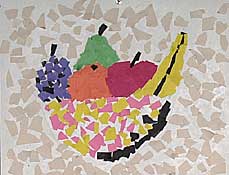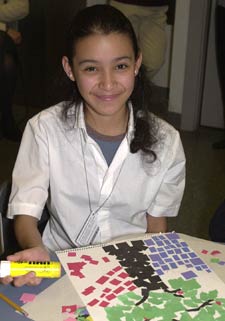

Lesson plan based on Mosaic Floor
Construct individual mosaics that simulate ancient Roman techniques of manipulating tesserae to create three—dimensional illusions.
Skills and Focus: Studio, Art Appreciation
Subject Area: Fine Arts
Thematic Connection: Identifying Patterns
Grade Level: Secondary School
Time Needed: 80 minutes
Objectives
• Explore the elements of contrast, emphasis, pattern, and color schemes by identifying how the artist manipulated tesserae in the mosaic.
• Explain how the use of tesserae creates specific effects, such as a sense of volume or shadowing.
• Create original mosaics by manipulating torn paper to depict different textures and details.
Instructional Materials Needed
Stories: What Animal Is This? and How Were Mosaics Made?
Pencils
11 x 17" construction paper or cardstock
Construction paper in a variety of colors, torn into small pieces of uniform size (approximately 1/2" square)
Glue sticks
Foil, ribbon, fabric remnants, or other materials as desired

Activity
Step 1: Explain to students that mosaics like this one were used to decorate private homes in ancient Rome. Discuss how mosaic artists created decorative patterns by making different shapes or lines with tesserae. Have students produce line drawings and experiment with patterns by manipulating paper tesserae on the drawings to create textures and details.
Step 2: Next have students produce a line drawing for an original mosaic design on 11 x 17" construction paper or cardstock, making notations for patterns and textures.
Step 3: Instruct students to fill in the drawings with tiny pieces of colored paper, foil, ribbon, or other materials. Discuss the process with students.
Critical Thinking Ask students to
• describe the techniques they use to produce the desired effects.
• explain how they manipulate the materials.
Goals
This activity meets Illinois State Goal 25: Know the language of the arts.
This activity meets Illinois State Goal 26: Through creating and performing, understand how works of art are produced.
© 2000, by The Art Institute of Chicago. All rights reserved. Use of this program is subject to the terms below. No part of this program may be reproduced, transmitted or distributed in any form or by any means, except for personal or classroom use. All Copyright in and to the program, in whole or in part, belongs to the publisher and its licensors and is registered with the U.S. Copyright Office